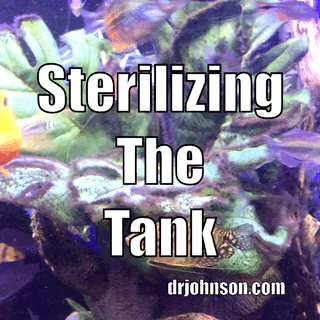“I’m going to break down, and sterilize the tank, gravel and plants.”
It’s promised often and it’s USUALLY unnecessary.
Sterilization of Environments is suggested as “The Way” to prevent diseases. This is widely advocated at the retail and wholesale level. They logically feel that a sterile environment is preferable to one that might harbor a pathogen from “the last batch” of fish. This is perfectly logical and actually works for some people.
On the other hand, it also means that your system (unless you use an existing filtration system which defeats the point of sterilization anyway) is starting from ‘scratch’ and will have to go through the entire nitrogen cycle again. This means that the incoming fish will have to bear up under Ammonia, then Nitrite, and then Nitrate, only then being rewarded by some algal growth and stability. I wager that the nitrogen ‘roller coaster’ is worse for the fish than anything (parasitic or bacterial) they could bring in with them.
Sterilization is usually unnecessary. It costs the system its entire ‘balance’ and you lose the beneficial bacteria and algae.
Besides, after you sterilize a system you’re only going to Bioseed it again, so it’s unsterile again.
After you’ve sterilized the tank and gravel, when the fish come back in, they will soon defecate in the tank, and will thereby (in most instances) inoculate the tank with the same pathogens that you’ve just tried to annihilate.
Most of the time, when you’re sterilizing a tank to “get rid of whatever killed the last batch” you’re actually trying to ‘sterilize’ a water quality problem that you didn’t know you had.
When the fish come in, you would observe the rules we laid out for Quarantine, especially observation (or the use of a microscope and diagnose any parasitic burden as early as possible). The earlier you diagnose and treat the fish, the better off you will be.
If you DO sterilize a tank, gravel and ornaments, set it up as new and do the following:
- Seachem Neutral 7.0 Buffer
- Plants for cover, live or plastic
- 78 DF temperature
- Sponge filter suitable to tank size
- Air pump to push sponge filter and aerate water
- Dechlorinate
- Bioseed
You won’t fail with the ‘new’ system.
Let’s just say, for the sake of argument that you’re not persuaded, and you want to be sure that there are no “leftover” pathogens in the tanks when your new fish come in. Here are some ideas you could employ with good success.
- Double dose Potassium permanganate with peroxide reversal. See formulary.
- Leave tank unoccupied for 14 days at seventy-five o This will eliminate parasitic pathogens, which require a host to survive for that long at that temperature.
- You could apply Formalin at 50 PPM with water change in four hours. This would also annihilate any parasite that might have been left behind. If you were concerned that flukes may have been there, you would repeat this treatment in 4 days.
- You can accomplish, against my advice, 100% annihilation of all viruses, bacteria and parasites with a 1:30 Clorox bleach dilution with water. Simply spray down tank or aquarium surfaces and wring out the sponges [or other filter media] with this dilute solution. Rinse with freshwater and refill, then you must de-chlorinate. Beneficial nitrifers are also annihilated.





